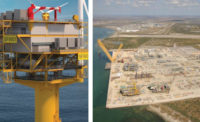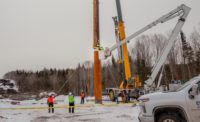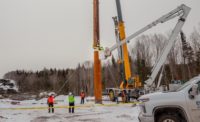Managing resilience is a marathon, not a sprint, said Rohit Aggarwala, commissioner of New York City's Dept. of Environmental Protection and the city's first chief climate officer.
“The reality is that for the rest of my life, we are going to be playing catch up to climate change, which is changing faster than our infrastructure can keep up,” he told attendees at ENR’s second annual NY-NJ Infrastructure Forum on Sept. 15 in Manhattan.
State and regional agency chiefs from New York and New Jersey addressed the looming mega-challenge of readying and developing regional energy and environmental infrastructure to meet climate change needs and risks.
The city released proposed guidelines this week to implement the landmark Local Law 97, which will require 50,000 buildings to comply with operational carbon limits that will incrementally increase starting next year, to reach a goal of net-zero carbon emissions by 2050. Buildings generate about 70% of New York City’s greenhouse gas emissions.
Aggarwala predicted compliance will require an estimated $12 billion to $15 billion in upgrades between now and 2030. The law remains controversial, but the DEP commissioner said it will be one of the city’s most important tools to address climate change.
The U.S. Army Corps of Engineers is now taking the lead on an estimated $61.5-billion program to redesign New York Harbor that will take three decades, but city agencies are also "actively engaged," Aggarwala said, with related projects already underway. Meanwhile, he said his agency will soon take responsibility in a dedicated office to oversee citywide coastal resilience.
Related to project funding, Aggarwala said the city was “structurally disadvantaged” to receive federal funding, due to population-size limits set by the state, which processes the money. He said his agency was awaiting word on potential changes to that exclusion.
Energized Infrastructure
Doreen Harris, president and CEO of the New York State Energy Research Development Authority (NYSERDA), noted major programs underway to develop billions of dollars of new clean energy infrastructure and expanded transmission to meet state climate law mandates and increased electrical power demand. The state law sets a target for 70% renewables by 2030, and a 100% zero-emission power grid by 2040.
By 2050, state peak demand will increase by up to 80%, state agencies estimate. “We need a grid that is not only expanded but more flexible and better able to respond to peaks and valleys,” she said. “We are integrally involved in the investments being made in overall infrastructure. Intersections between our agencies are ever more present because … we're looking at every sector of our economy.”

Transmission infrastructure is expanding across New York state to accelerate clean energy sources. Efforts include the 340-mile Champlain-Hudson Power Express line from Canada to New York City (not pictured), a privately funded and underground high-voltage line just underway.
Credit: NYSERDA
*Click the image for greater detail
NYSERDA’S new integration analysis “lays out pathways for this economy-wide transition,” Harris said. “Wind, water and sunlight will actually be the primary sources of the powering of our economy moving forward,” she added, with low-carbon fuels such as bio-energy and hydrogen set to be tapped for hard-to-decarbonize sectors.
Harris emphasized new transmission construction as the “unsung hero” to reach emission reduction targets. “Our investment to build out our infrastructure to support these goals is truly historic,” she said, terming it the largest transmission construction effort in New York in the last 50 years.
Pushing the Transition
Projects include U.S.-side construction now getting underway for the 340-mile Champlain Hudson Power Express, an estimated $6-billion buried cable that will carry high-voltage hydropower from Canada to New York City, which is still mostly powered by natural gas. The state-sanctioned project is privately funded by investor giant Blackstone.
Construction began last November in upstate New York, with work getting underway in June on the project's converter station in Astoria, Queens, with Kiewit Corp. as lead contractor.
"We are actively building this project as we speak,” Gene Martin, president of Blackstone unit TDI told Forum attendees.
He said the line will provide about 20% of the energy needed in New York City, replacing power lost by nuclear power plant closure in the region. Once operating in 2026, the cable will be the largest transmission line in the U.S. built entirely underwater and underground.
“It’s an interesting world we are in, in terms of political aspirations and what we want to achieve to get to that renewable economy,” said Martin, a former AECOM executive.
Harris said new local and bulk transmission projects, which she termed "game changers," are set to deliver one-third of New York City's annual electric consumption. Infrastructure also is underway to meet the state mandate to generate 9 GW of offshore wind energy by 2035. The state's first project, the 132-MW South Fork Wind off Long Island, is set to complete construction this year. Other work involves developing new port and manufacturing facilities in New York and New Jersey for project component production and assembly.
Some recent construction cost headwinds, which Harris acknowledged as "significant and unforeseen by the industry," have offshore wind developers in the region seeking contract adjustments and raising concerns about added project delay.
New Jersey Gov. Phil Murphy and New York Gov. Kathy Hochul joined peers in key offshore wind developing states Connecticut, Maryland, Massachusetts and Rhode Island in a Sept. 13 letter to President Joe Biden that said the growing cost risk could delay his set goal to have 30 GW of U.S. projects built by 2030.
They seek Biden's intervention to have the U.S. Treasury clarify that offshore wind projects are "fully eligibie" for federal tax credits under recent law; that wind site lease revenue to the U.S. government be shared with states; and that permit constraints be eliminated.
"Absent intervention, these near-term projects are increasingly at risk of failing," the governors said, with U.S. deployment "at serious risk of stalling" if state ratepayers alone have to absorb major new costs.
“This reflects that we are not living in a world that is a very straight line,” Harris said. “It's important for all of us not to be blindly optimistic about how we get from here to there.”
UPDATE: NYSERDA announced on Sept. 28 an agreement with the U.S. Energy Dept. for added federal clean energy financing for offshore wind and other large-scale renewable projects. Gov. Hochul said it will enable the state to leverage funds under DOE's Title 17 Clean Energy Financing Program that was expanded by the 2022 climate law. The agency can finance projects for up to 80% of eligible costs, not exceeding 30 years.
“To ensure New York achieves a zero-emissions grid, the financing process for clean energy projects must be streamlined,” said Hochul. "Time is of the essence." NYSERDA said it and DOE "have defined a process to facilitate the review of applications from offshore and onshore wind and grid-scale solar [projects] applying for financing." These could include projects under contract with NYSERDA and those set to be.
The link will enable clean energy projects in New York "to access alternative financing options considering the current inflationary and high interest rate environment," said Harris. "Any cost savings that could benefit projects from accessing [DOE] loans could be shared with New York State ratepayers and potentially enable billions of dollars in savings."
Projects related to innovative energy production, manufacturing and infrastructure reinvestment would be eligible for funding, said NYSERDA.
Core Priorities
For the Port Authority of NY and NJ, “sustainability is one of the official core priorities," said Rizwan Baig, chief engineer, with a particular emphasis on decarbonization and reducing operational emissions. This can be seen in significant terminal construction, under way or completed, at John F. Kennedy International Airport, Newark Liberty International Airport and LaGuardia International Airport. “We have some of the largest solar installations in the country,” he said, with work ongoing at Newark Airport and set to be a feature of Terminal 1 at JFK Airport, now being built.
Baig also said Port Authority has spent over $2 billion to date on recovery and resilience measures, with climate risk assessments and action plans integral to “help manage uncertainty.”
The agency is looking to its next round of procurements, including Design/PM-CM for mass transit and airport access improvements at LaGuardia, said Baig. Plans include a new continuous electric shuttle service from the airport to the Astoria-Ditmas Boulevard subway station in Queens, which will also undergo ADA-compliance upgrades; add a bus depot; and make Terminal C traffic improvements. Also to be announced shortly, said Baig, are two design services RFPs for the $19-billion JFK project.
The agency also is exploring integration of artificial intelligence (AI), electrification and 3D-printing technologies into Port Authority plans. Baig noted work underway for autonomous shuttles at Newark and JFK airports.
Coping With Project Risk
As project challenges across all sectors grow exponentially along with their size, execution risks “are more intertwined and complex,” said Jamey Barbas, a veteran regional transportation agency megaproject executive, noting schedule demand, staffing shortfalls and unforeseen costs.
“Most concerning are the stacked challenges in energy transition,” added Kent Herzog, Northeast managing director at Burns & McDonnell, who said needs for rapid electrification are “huge, not incremental."
He also pointed to permitting and regulatory hurdles and a lack of component standardization. “Our industry has 50 different sizes of conductors and almost every single size of transformer,” he said. “Laws put the money out there, now we have to find the resources.”
Mike Taylor, head of ports for Equinor US Renewables, noted flaws in risk allocation at the project level. He said an offshore wind project developer must assume risk linked to costs and schedule of a grid upgrade “usually before they’re known or at least estimated to the degree any one of us would feel comfortable signing on to."
Said Taylor: “Better allocation means better execution and lower cost to the whole supply chain."
“Most concerning are the stacked challenges in energy transition. Laws put the money out there, now we have to find the resources."
Kent Herzog, Northeast managing director, Burns & McDonnell
Risks for infrastructure megaprojects getting underway are not just local, added Joe Cazares, program management director at Jacobs, with supply chain progress impacted by things “like containers coming through the Panama Canal and $1.6 trillion in Middle East construction sucking up a lot of talent.”
The dimensions of infrastructure programs starting and planned pose challenges for cities like New York City, said Jamie Tores-Springer, president of its transportation agency unit MTA Construction and Development.
“Getting new transmission to the city will be very complex,” he said, noting aspects of “building in a dense urban environment that we can’t change.” He said owners can help by “providing lead time and predictability” in structuring procurement. Related to advance “strategic sourcing” of materials, Torres-Springer noted the benefits but said MTA still sees risk. “We’re worried we would buy something that didn’t make sense in a system, once our builder was on board,” he said.
Panelists see AI as a potential risk mitigator but with its own current limitations. Burns & McDonnell has begun using it to create an internal Chat GPT to respond to owner RFPs, “trying to create in seconds a 60% draft proposal that a human could use as a basis for a proposal," said Herzog. "We’re trying to go from a 3D modeled infrastructure project to a 60% design package with no human interaction."
Equinor uses AI for analysis of wind and ocean patterns, said Taylor, but said “until it gets smart enough to differentiate fake news and real news, it won't replace human common sense.” Echoed Cazares: "It’s well written, but misses the point.”
Barbas estimated “It will take three years for AI to get to a place to realize schedule optimization.”









Post a comment to this article
Report Abusive Comment